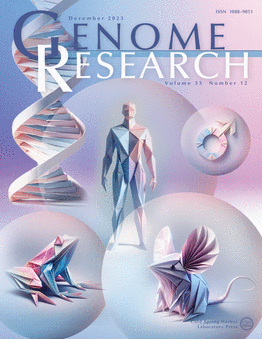Optical genome mapping enables accurate testing of large repeat expansions
IF 6.2
2区 生物学
Q1 BIOCHEMISTRY & MOLECULAR BIOLOGY
引用次数: 0
Abstract
Short tandem repeats (STRs) are common variations in human genomes that frequently expand or contract, causing genetic disorders, mainly when expanded. Traditional diagnostic methods for identifying these expansions, such as repeat-primed PCR and Southern blotting, are often labor-intensive, locus-specific, and are unable to precisely determine long repeat expansions. Sequencing-based methods, although capable of genome-wide detection, are limited by inaccuracy (short-read technologies) and high associated costs (long-read technologies). This study evaluated optical genome mapping (OGM) as an efficient, accurate approach for measuring STR lengths and assessing somatic stability in 85 samples with known pathogenic repeat expansions in DMPK, CNBP, and RFC1, causing myotonic dystrophy types 1 and 2 and cerebellar ataxia, neuropathy, and vestibular areflexia syndrome (CANVAS), respectively. Three workflows—manual de novo assembly, local guided assembly (local-GA), and a molecule distance script—were applied, of which the latter two were developed as part of this study to assess the repeat sizes and somatic repeat stability. OGM successfully identified 84/85 (98.8%) of the pathogenic expansions, distinguishing between wild-type and expanded alleles or between two expanded alleles in recessive cases, with greater accuracy than standard of care (SOC) for long repeats and no apparent upper size limit. Notably, OGM detected somatic instability in a subset of DMPK, CNBP, and RFC1 samples. These findings suggest OGM could advance diagnostic accuracy for large repeat expansions, providing a more comprehensive genome-wide assay for repeat expansion disorders by measuring exact repeat lengths and somatic instability across multiple loci simultaneously.光学基因组作图能够精确地检测大量重复扩增
短串联重复序列(STRs)是人类基因组中常见的变异,经常扩增或收缩,主要在扩增时引起遗传疾病。识别这些扩增的传统诊断方法,如重复引物PCR和Southern blotting,通常是劳动密集型的,位点特异性的,并且不能精确地确定长重复扩增。基于测序的方法虽然能够进行全基因组检测,但受到不准确性(短读技术)和相关成本高(长读技术)的限制。本研究评估了光学基因组定位(OGM)作为一种有效、准确的方法,用于测量STR长度和评估85个样本的躯体稳定性,这些样本的DMPK、CNBP和RFC1中已知的致病性重复扩增,分别导致1型和2型肌强直性营养不良和小脑共济失调、神经病变和前庭反射综合征(CANVAS)。应用了三个工作流程-手工从头组装,局部引导组装(local- ga)和分子距离脚本,其中后两个是作为本研究的一部分开发的,用于评估重复序列大小和体细胞重复序列稳定性。OGM成功鉴定了84/85(98.8%)的致病扩增,区分了野生型和扩增等位基因,或在隐性病例中区分了两个扩增等位基因,对于长重复序列,OGM的准确性高于标准护理(SOC),并且没有明显的大小上限。值得注意的是,OGM在DMPK、CNBP和RFC1样本的子集中检测到体细胞不稳定性。这些发现表明,OGM可以提高大重复扩增的诊断准确性,通过同时测量多个位点的精确重复长度和体细胞不稳定性,为重复扩增疾病提供更全面的全基因组检测。
本文章由计算机程序翻译,如有差异,请以英文原文为准。
求助全文
约1分钟内获得全文
求助全文
来源期刊

Genome research
生物-生化与分子生物学
CiteScore
12.40
自引率
1.40%
发文量
140
审稿时长
6 months
期刊介绍:
Launched in 1995, Genome Research is an international, continuously published, peer-reviewed journal that focuses on research that provides novel insights into the genome biology of all organisms, including advances in genomic medicine.
Among the topics considered by the journal are genome structure and function, comparative genomics, molecular evolution, genome-scale quantitative and population genetics, proteomics, epigenomics, and systems biology. The journal also features exciting gene discoveries and reports of cutting-edge computational biology and high-throughput methodologies.
New data in these areas are published as research papers, or methods and resource reports that provide novel information on technologies or tools that will be of interest to a broad readership. Complete data sets are presented electronically on the journal''s web site where appropriate. The journal also provides Reviews, Perspectives, and Insight/Outlook articles, which present commentary on the latest advances published both here and elsewhere, placing such progress in its broader biological context.
 求助内容:
求助内容: 应助结果提醒方式:
应助结果提醒方式:


